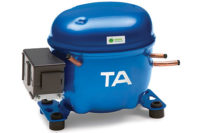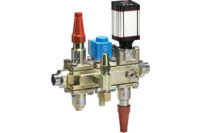The only thing is, what are you going to do with all those R-22 units you’ve been installing and servicing for years now? Those units could well last for years to come, well after supplies of R-22 fall below the demand for the refrigerant. And, according to the United States Environmental Protection Agency, it is totally legal to continue to operate such equipment for as long as you can.
One solution is to retrofit that equipment that has been running on HCFC-22 with an HFC refrigerant. The only problem is that HFC can’t be R-410A. “Components of an R-22 system are not designed for the higher pressures of R-410A and the mineral oil used with R-22 is not compatible with R-410A,” said Mark Gallier, a technical trainer for International Comfort Products.
But the industry has come up with a number of refrigerants their manufacturers say can be retrofitted into existing R-22 systems even though any one does not necessarily encompass the entire application range of R-22. But by consulting with manufacturers, and following manufacturer recommendations, equipment can continue to be used through its normal life by using these retrofit refrigerants.
“Service-related refrigerant products are rapidly growing in acceptance as they provide a safe, easy-to-use, efficient, and price-practical solution to the R-22 crisis,” said Gordon McKinney, vice president and chief operating officer of ICOR International.
For the most part, the HFC refrigerants being offered for the service-related retrofits can run with the existing mineral oil of the R-22 unit thanks to the addition of a bit of HC refrigerants such as isobutene or propane in the blend to allow for better oil return. However, there are also HFC retrofit refrigerants without HCs that require a changeout of oil.
ALTERNATIVES
Here are among the most prominent of the retrofit HFC refrigerants:R-417A:The refrigerant is described as a retrofit application “for R-22 in direct expansion stationary air conditioning and in medium-temperature commercial refrigeration,” according to a statement from DuPont. Applications include residential and commercial air conditioning as well as food service, supermarket display cases, and food storage and processing refrigeration. It has a lower discharge temperature than R-22 and toxicity similar to R-22. It is compatible with mineral oil (MO), alkyl benzene (AB) and polyolester (POE).
R-422A:The refrigerant can be used to “replace R-22, R-502, and HCFC-containing refrigerant blends in low-temperature commercial and industrial direct expansion refrigeration systems” and “can also be used in medium temperature,” said DuPont. No lubricant retrofit is required. Applications include food service, supermarket display cases, food storage and processing, and ice machines.
R-422B:The refrigerant is billed as “a direct replacement for R-22 that is nontoxic, nonflammable HFC,” according to a statement from ICOR International. “It is safe for the user and environmentally friendly, requiring no unnecessary oil change or major system modifications.” It is designed for use in systems utilizing direct expansion metering. Converting to R-422B will not increase system capacity, the manufacturer said.
R-422C:The refrigerant “replaces R-22 for low-temperature and medium-temperature applications,” according to ICOR, as well as such CFCs as 502. It is compatible with MO, AB, and POE-based oils. According to ICOR, R-422C has higher capacity of coefficiency of performance than R-404A and R-507A, 20 percent lower global warming potential, and lower compression ratio.
R-422D:The refrigerant is “for replacing R-22 in medium-temperature direct expansion refrigeration applications,” but also can be used for low-temperature including commercial supermarket systems, and stationary DX air conditioning applications, including DX water chillers,” according to DuPont. “Field testing has been successful in many systems with no TXV change although a superheat adjustment may be required.”
R-427A:This is the refrigerant using POE oil, although “it works well with residual mineral oil,” according to a statement from Arkema. It was said to have a comparable capacity versus R-22. “Only one oil change to POE oil” was needed, it was noted. “No flushing is required.” Other than that, “No modification of the installation is required.” It can be used to retrofit low-temperature refrigeration and air conditioning installations.
R-428A:It is being marketed as an R-22 and CFC-502 replacement and is being used in some supermarkets in Canada, according to ComStar International. “In the U.S., we are in negotiations with a nationwide refrigeration wholesaler to promote and market this refrigerant,” said ComStar’s Steve Mella.
R-434A:This refrigerant is being promoted as an alternative for R-22 in “larger low-temp refrigeration systems,” said ComStar’s Mella.
R-438A (pending ASHRAE approval):DuPont stated that this refrigerant “combines R-22 pressure-enthalpy characteristics with mineral oil compatibility in a unique HFC refrigerant that can be used to replace R-22 over a wide range of evaporator temperatures.” Applications can include commercial and residential air conditioning, as well as low- and medium-temperature refrigeration.
CHANGING SECTOR
The sector is a fluid one with refrigerants sometimes coming to the market for a while only to be withdrawn. Also, manufacturer sources can sometimes change. But those involved in the sector encourage a closer study of the HFC retrofit option.Those involved say contractors should consider these refrigerants for a variety of reasons.
“Companies trying to convince consumers that replacing their equipment is the only practical option are poorly informed about the performance success of R-22 direct replacements,” said McKinney.
“Actually, there are four basic ways users can close the (R-22 supply-demand) gap: replace the equipment; recover, recycle or reclaim old refrigerant; reduce system leaks; and convert existing R-22 systems to an alternative HFC refrigerant.”
Publication date:06/22/2009



